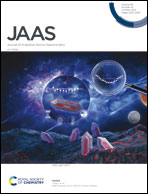Further characterization of SA01 and SA02 zircon reference materials for Si and Zr isotopic compositions via femtosecond laser ablation MC-ICP-MS†
Abstract
Here we present Si and Zr isotopic data of SA01 and SA02 zircons via multi-technique analytical methods to evaluate the suitability of the two zircon reference materials for in situ Si and Zr isotopic analysis using femtosecond laser ablation multi-collector inductively coupled plasma mass spectrometry (fs-LA-MC-ICP-MS). Precise and accurate Si and Zr isotopic compositions were determined by solution nebulization (SN) MC-ICP-MS. Fifteen SN-MC-ICP-MS Si isotopic measurements on two aliquots of SA01 zircon solutions gave consistent results with an average δ30Si (relative to NBS28) value of −0.29 ± 0.08‰ (2SD), whereas a slight inter-grain offset was detected for the SA02 zircon with an average δ30Si value of −0.25 ± 0.16‰ (2SD, n = 12). The mean δ94/90Zr (relative to IPGP-Zr) values were 0.02 ± 0.03‰ (2SD, n = 9) and 0.02 ± 0.04‰ (2SD, n = 9) for SA01 and SA02 zircons, respectively. Extensive homogeneity test of both Si and Zr isotopic compositions was performed on SA01 and SA02 zircons by spot analysis with fs-LA-MC-ICP-MS. The Si and Zr isotopic results for SA01 zircon showed good agreement with our SN-MC-ICP-MS measurements, as did the Zr isotope results of SA02 zircon. In spite of the inter-grain offset in the Si isotopic composition revealed by SN-MC-ICP-MS, intra-grain homogeneity was confirmed for SA02 zircon by the LA-MC-ICP-MS method. In situ analyses of SA01 and SA02 zircons yielded mean δ30Si values of −0.24 ± 0.10‰ (2SD, n = 143) and −0.26 ± 0.12‰ (2SD, n = 135), and mean δ94/90Zr values of 0.03 ± 0.09‰ (2SD, n = 153) and 0.02 ± 0.09‰ (2SD, n = 153), respectively. Both solution and in situ dataset demonstrated the suitability of SA01 for calibrating in situ zircon Si and Zr isotopic analysis. We suggest that SA02 zircon is also a suitable reference material for micro-beam Zr isotopic analysis as well as a monitor for in situ Si isotopic analysis. Furthermore, an analytical approach using the spot mode of fs-LA is presented in this study. In situ Si and Zr isotopic analysis may benefit from it for improving spatial resolution and precision.



 Please wait while we load your content...
Please wait while we load your content...